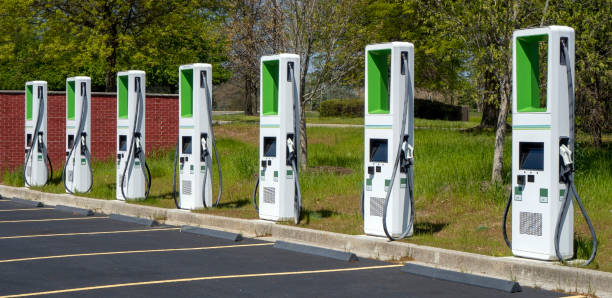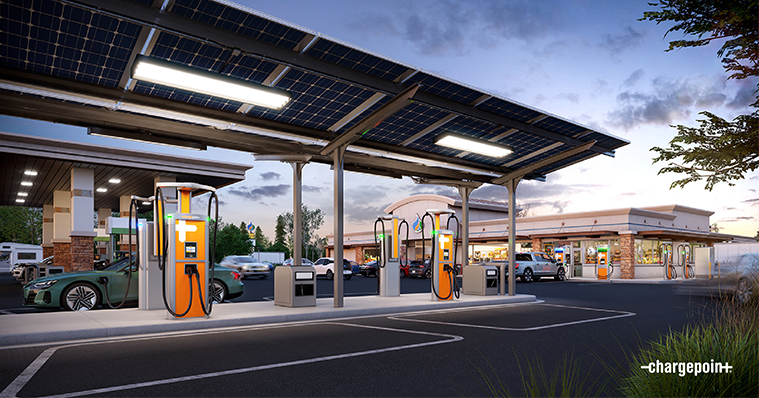
EV infrastructure refers to the infrastructure that is necessary to support the use of electric vehicles (EVs). This includes charging stations for EVs, as well as the electrical grid and other supporting infrastructure that is necessary to power these vehicles.
Charging stations for EVs can be found in a variety of locations, including at homes, workplaces, public parking lots, and along highways. These charging stations can be classified into different categories based on the type of charging they provide. Level 1 charging stations use a standard 110-volt outlet and can provide a slow charge for EVs, while Level 2 charging stations use a 240-volt outlet and can provide a faster charge. Level 3 charging stations, also known as DC fast charging stations, use a high-voltage direct current and can charge an EV to 80% in about 30 minutes.
In addition to charging stations, EV infrastructure also includes the electrical grid and other supporting infrastructure that is necessary to power EVs. This includes power plants, transmission and distribution lines, and other components of the electrical grid that generate and deliver electricity to charging stations.
Overall, the development of EV infrastructure is an important part of the transition to electric transportation, as it helps to ensure that EVs have the necessary support to function and become more widely adopted.
How can I set up EV infrastructure for the United States?

There are several steps that can be taken to set up EV infrastructure in the United States:
- Identify the demand for EV charging: It is important to understand the level of demand for EV charging in a given area. This can help to determine the number and type of charging stations that will be needed.
- Determine the appropriate locations for charging stations: Charging stations should be located in convenient and easily accessible locations, such as near highways, in public parking lots, and at workplaces.
- Choose the right type of charging stations: There are several different types of charging stations available, including Level 1, Level 2, and DC fast charging stations. The right type of charging station will depend on the needs of the local EV community and the availability of electrical infrastructure.
- Install charging stations: Once the locations and types of charging stations have been chosen, they can be installed. This typically involves obtaining the necessary permits, hiring contractors, and ensuring that the charging stations are properly connected to the electrical grid.
- Promote the use of EVs and charging stations: In order to encourage the adoption of EVs, it is important to educate the public about the benefits of electric transportation and the availability of charging infrastructure. This can be done through marketing campaigns, events, and other outreach efforts.
Overall, the development of EV infrastructure requires a combination of planning, funding, and collaboration between various stakeholders, including government agencies, utilities, businesses, and community organizations.

Certainly! Here are some additional considerations for setting up EV infrastructure in the United States:
Funding: The cost of installing EV charging stations can vary significantly depending on the type of charging station, the location, and the electrical infrastructure that is already in place. There are various funding options available to help cover these costs, including grants, incentives, and low-interest loans from government agencies and utilities.
Partnerships: Partnerships with businesses, community organizations, and other stakeholders can be an important part of the process of setting up EV infrastructure. For example, a business might install charging stations at their workplace to support the use of EVs by employees, or a community organization might work with a local government to install charging stations in a public parking lot.
Standards and regulations: There are various standards and regulations that apply to the installation and operation of EV charging stations, including electrical codes, building codes, and zoning regulations. It is important to be familiar with these requirements and to ensure that charging stations are installed and operated in compliance with these standards.
Maintenance and operations: Charging stations require regular maintenance to ensure they are functioning properly and are safe to use. This may include tasks such as cleaning, software updates, and electrical inspections. It is important to have a plan in place for maintaining and operating charging stations to ensure they are available for use by EV drivers.
Customer experience: The customer experience is an important consideration when setting up EV infrastructure. This includes factors such as the availability of charging stations, the convenience of the charging process, and the overall user experience. It is important to prioritize the needs and preferences of EV drivers in order to encourage the use of electric transportation.
EV approval from the government

There are typically various approvals and permits required when setting up EV infrastructure in the United States. This may include obtaining permission from local, state, and federal agencies, as well as complying with various regulations and standards that apply to the installation and operation of charging stations.
For example, the installation of EV charging stations may require building permits from the local municipality, and may also be subject to electrical codes and building codes. In some cases, it may be necessary to obtain approval from utility companies or other agencies in order to connect charging stations to the electrical grid.
In addition to these approvals, it is also important to consider the impact that EV infrastructure may have on the local community and environment. This may involve conducting environmental assessments, obtaining necessary permits and approvals from regulatory agencies, and engaging in public outreach efforts to inform the community about the proposed EV infrastructure.
Overall, the approval process for setting up EV infrastructure can vary depending on the specific location and circumstances, and it is important to be familiar with the relevant requirements and procedures in order to ensure that EV infrastructure is installed and operated in a safe and compliant manner.
Capital cost for the electric vehicle

The capital cost of EV infrastructure can vary significantly depending on a number of factors, including the type of charging station, the location, and the electrical infrastructure that is already in place.
For example, the cost of installing a Level 1 charging station, which uses a standard 110-volt outlet and can provide a slow charge for EVs, may be relatively low. However, the cost of installing a Level 2 charging station, which uses a 240-volt outlet and can provide a faster charge, or a DC fast charging station, which uses a high-voltage direct current and can charge an EV to 80% in about 30 minutes, may be higher.
Other factors that can impact the capital cost of EV infrastructure include the distance from the electrical grid, the availability of existing electrical infrastructure, and the need for any upgrades or modifications to the electrical system.
In general, the cost of installing EV infrastructure can range from a few thousand dollars for a single Level 1 charging station to several hundred thousand dollars or more for a network of Level 2 or DC fast charging stations. It is important to carefully consider the costs and benefits of different types of charging stations in order to make informed decisions about the most appropriate and cost-effective EV infrastructure for a given location.
Operation cost
The operation cost of EV infrastructure includes the expenses associated with maintaining and operating charging stations, as well as any costs associated with connecting charging stations to the electrical grid.
Some of the factors that can impact the operation cost of EV infrastructure include:
Maintenance: Charging stations require regular maintenance to ensure they are functioning properly and are safe to use. This may include tasks such as cleaning, software updates, and electrical inspections.
Electricity: The cost of electricity can vary depending on the location and the type of charging station. Level 1 charging stations, which use a standard 110-volt outlet, may have lower electricity costs compared to Level 2 charging stations, which use a 240-volt outlet, or DC fast charging stations, which use a high-voltage direct current.
Staffing: In some cases, it may be necessary to hire staff to operate and maintain EV infrastructure. This may include technicians to perform maintenance and repairs, customer service representatives to assist EV drivers, and other personnel.
Rent or lease: If EV infrastructure is installed on property that is not owned by the operator, there may be costs associated with rent or lease payments.
Insurance: Insurance coverage may be necessary to protect against potential liability or other risks associated with EV infrastructure.
Overall, the operation cost of EV infrastructure can vary depending on the specific circumstances and the size and complexity of the charging network. It is important to carefully consider these costs and plan for them when setting up and operating EV infrastructure.
Electric Vehicle market sizing
Market sizing refers to the process of estimating the size of a market, or the total demand for a particular product or service. In the context of EV infrastructure, market sizing would involve estimating the demand for charging stations and related services in a given location.
There are several factors that can impact the market size for EV infrastructure, including:
Number of EVs: The market size for EV infrastructure is likely to be directly influenced by the number of EVs on the road. As the number of EVs increases, there will be a corresponding increase in demand for charging stations and related services.
Range of EVs: The range of EVs, or the distance that they can travel on a single charge, can also impact the market size for EV infrastructure. EVs with longer ranges may require fewer charging stops, while EVs with shorter ranges may require more frequent charging.
Charging habits of EV drivers: The charging habits of EV drivers can also impact the market size for EV infrastructure. For example, if a large percentage of EV drivers prefer to charge their vehicles at home or at work, the demand for public charging stations may be lower.
Government incentives and regulations: Government incentives and regulations can also impact the market size for EV infrastructure. For example, governments may offer financial incentives to encourage the adoption of EVs, or may implement regulations that require the installation of charging stations in certain locations.
Overall, the market size for EV infrastructure is likely to be influenced by a combination of these and other factors. Estimating the market size for EV infrastructure can help stakeholders to understand the potential demand for charging stations and related services, and to make informed decisions about the development and deployment of EV infrastructure.
conclusion
In conclusion, EV infrastructure refers to the infrastructure that is necessary to support the use of electric vehicles (EVs), including charging stations and the electrical grid and other supporting infrastructure. The development of EV infrastructure is an important part of the transition to electric transportation, as it helps to ensure that EVs have the necessary support to function and become more widely adopted.
Setting up EV infrastructure involves a range of considerations, including identifying the demand for EV charging, determining the appropriate locations for charging stations, choosing the right type of charging stations, obtaining necessary approvals and permits, and promoting the use of EVs and charging stations. The capital and operation costs of EV infrastructure can vary depending on a number of factors, including the type of charging station, the location, and the electrical infrastructure that is already in place.
The market size for EV infrastructure can be influenced by the number of EVs on the road, the range of EVs, the charging habits of EV drivers, and government incentives and regulations. Estimating the market size for EV infrastructure can help stakeholders to understand the potential demand for charging stations and related services, and to make informed decisions about the development and deployment of EV infrastructure.









